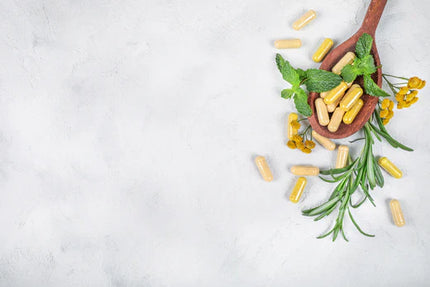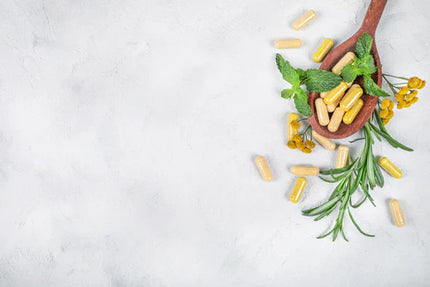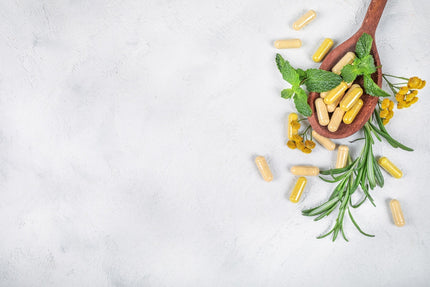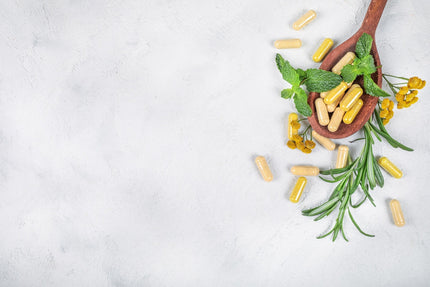Herbs That May Assist
Cordyceps
Cordyceps sinensis, hyphae dry
Coriolus/Kawaratake
Trametes versicolor, hyphae dry
Reishi
Ganoderma lucidum, fruiting body dry
Shiitake
Lentinula edodes, fruiting body dry
Actions
- Immune enhancement, surveillance and modulation
- Antiviral
- Antibacterial
Clinical Applications
- Recurrent infections
- Viral infections
- Upper respiratory tract infections
- Bacterial infections
Clinical Overview
The immune system is constantly exposed to viruses and bacteria, which can lead to acute infection. In those with inadequate immune defences, acute infections can become recurrent, impacting quality of life. Japanese mushrooms, including cordyceps, coriolus, reishi and shiitake, enhance the body’s immune response and provide antiviral and antibacterial actions (Figure 1), thereby supporting recovery from acute and recurrent infections, while increasing resistance to infectious illness. Specifically, these mushrooms activate the innate immune system, triggering the production of natural killer (NK) cells, lymphocytes, neutrophils, macrophages, and inflammatory cytokines. [1] Cytokine synthesis prompts adaptive immune processes to take effect, through the promotion of B cells for antibody production, and stimulation of T cells, which mediate cellular and humoral immunity. [2] Therefore, cordyceps, coriolus, reishi and shiitake mushrooms serve as key stimulators of the immune response, and may be utilised in the prevention and treatment of acute and recurrent infections.

Figure 1: The immune-enhancing, antiviral and antibacterial actions of cordyceps, coriolus, reishi and shiitake mushrooms.
Background Information
In order for a pathogen to successfully survive within a host, it must overcome host immune defences, invade the tissues and replicate at the site of infection. In cases where the immune system is compromised, or when pathogens are highly virulent, the potential for acute infections to become recurrent can increase. Thus, efficient and effective immune defences are essential when coping with the increasing virulence of pathogens, to minimise the risk of infection.
Medicinal mushrooms are a rich source of many bioactive metabolites that enhance host defence mechanisms, helping to overcome pathogenic burden. [3] The most widely researched, active polysaccharide components are the non-digestible β-linked polysaccharides, β-glucans, [4] however α-glucans have also shown immune-enhancing activity. [5] Each medicinal mushroom contains signature polysaccharide constituents responsible for their therapeutic benefit. Whilst these individual components display unique immunomodulatory activities, the mechanisms behind their actions are universal to medicinal mushroom polysaccharides.
Due to their high molecular weight, mushroom polysaccharides are not able to penetrate immune cells to activate them directly. [6] Instead, they interact with immune cells by binding to cellular receptors such as dectin-1, complement receptor 3 (CR3), lactosylceramide (LacCer), and toll-like receptor (TLR) 2, activating various cellular immune responses and multiple signaling pathways within the host (Figure 2). [7] For instance, stimulation of the dectin-1 receptor pathway activates macrophages, promoting the innate immune response by increasing phagocytosis of pathogens, producing cytokines, and initiating proteolytic processing of foreign antigens. [8] Further, synergistic actions of dectin-1 and TLR-2 generate a strong immune response by stimulating cytokines such as tumor necrosis factor alpha (TNF-α), interleukin (IL)-2 and IL-12. [9]
Additionally, stimulation of the CR3 receptor increases immune surveillance and detection of a range of microbial cells, resulting in the formation of the CR3 receptor-microbial cell complex. [10] This molecular complex is then presented to neutrophils, monocytes and NK cells to be neutralised and eliminated. [11] Similarly, polysaccharide binding to LacCer also promotes complex formation between LacCer and microbial cells, whilst activation of TLRs stimulates detection of fungi, bacteria, viruses and protozoa. [12] Therefore, by modifying immune responses, medicinal mushrooms aid host adaptation to various immune stressors. [13]

Figure 2: Mechanism of immune activation by mushroom polysaccharides. [14]
Actions
Immune Enhancement, Surveillance and Modulation
The bioactive components of cordyceps mushroom have been shown to enhance immune function through multiple mechanisms, providing broad-spectrum therapeutic potential for the management of both acute and recurrent infections. Its pharmacological compounds, which include adenosine and cordycepin, stimulate host defence mechanisms such as macrophage and phagocytic activity, and up-regulate TNF-α, IL-6, IL-10, IL-12 and inducible nitric oxide synthase (iNOS), involved in the cellular immune response. [15]
Further, the β-glucan Cordyceps sinensis insoluble polysaccharide (CS-Pp), has been shown to induce cytokine production, including TNF-α, and promote monocyte activation. [16] Additionally, CS-Pp promotes T cell-secreted IL-5, which is involved in the proliferation and differentiation of B cells. [17] , [18] Further, its acid polysaccharide (APS) stimulates macrophage polarisation to an M1 phenotype by activating the nuclear factor kappa B (NFkB) pathway involved in the inflammatory immune response. [19] Accordingly, the activation of M1 macrophages by APS initiates a first line of defence against intracellular pathogens.
Cordyceps has also been shown to enhance cell-mediated immunity in response to bacterial infection. Specifically, cordyceps is associated with reduced production of IL-10, a cytokine that lowers resistance to bacterial infection by inhibiting macrophage activation and counteracting the function of T helper (Th) 1 lymphocytes, causing diminished Th1 cytokine production. [20] Cordyceps’ capacity to inhibit IL-10 subsequently increases macrophage activity and phagocytosis, and increases Th1 immune activation, promoting antibacterial defence.
The polysaccharide, UM01, present within coriolus, exhibits immune-enhancing properties including phagocytic stimulation and promotion of nitric oxide (NO) release, whilst also increasing cytokine and chemokine production in macrophages. [21] In addition, polysaccharopeptide (PSP) and polysaccharide krestin (PSK), bioactive components of coriolus, also support immune function. PSP initiates:
- Immune cell activation and pathogenic recognition [22];
- Phagocytic activity of macrophages [23];
- Expression of cytokines and chemokines such as TNF-α, IL-1β and IL-6 [24];
- Prostaglandin E2 (PGE2) production (the principal prostaglandin in the acute inflammatory response) [25];
- Filtration of dendritic cells, increasing detection of infectious stimuli and initiating a T cell response for defence against pathogens. [26]
Like PSP, PSK also stimulates cytokine production, specifically TNF-α, IL-1β and IL-12. The overlapping actions of these polysaccharides are due to their shared β-glucan content. By interacting with receptors dectin-1, TLR-2, TLR-4, TLR-6, and CR3, both components activate a group of immune cells that express these receptors. [27] However, unlike PSP, PSK also elicits immune-enhancing actions via activating cytotoxic CD8+ T cells and NK cells, which defend against intracellular pathogens, including viruses and bacteria. [28] Coriolus therefore supports immune function via a variety of mechanisms.
More than 150 biologically active polysaccharides have been isolated from reishi, with research confirming these active constituents have immune-enhancing, antiviral and antibacterial effects. [29] Of note are the Ganoderma lucidum proteoglycans (GLPGs), which enhance immune surveillance via:
- Binding to cell-surface receptors of immune cells, leading to alteration in the activities of macrophages, T helper cells and NK cells [30];
- Activating peripheral blood mononuclear cells (PBMCs), including lymphocytes, monocytes and granulocytes, which activate an innate anti-infective and inflammatory response [31];
- Promoting lymphocyte proliferation and differentiation [32];
- Inhibiting viral replication [33];
- Promoting antibody production. [34]
These actions have been attributed to the binding of reishi polysaccharides to TLR, CR3, LacCer and dectin-1 receptors, prompting an increase in immune surveillance and response. [3]
The β-glucan constituents present within shiitake are also regarded for their immune-stimulating properties. Through binding with immune cell receptors, these substances potentiate the activity of T cells, macrophages and NK cells, whilst also stimulating the expression of cytokines produced by lymphocytes, [36] activating and modulating their release. [37] One of shiitake’s active constituents, lentinan, may also enhance host defence mechanisms by increasing TNF-α, IL-1, IL-3 and interferon, which promote immune cell development and differentiation. Lentinan also enhances T helper cell activity, leading to the restoration of humoral immune responses. [38] Moreover, the engulfing activity of macrophages is shown to increase in the presence of lentinan, prompting them to seek out threats to host wellbeing. [39]
Antiviral
Reishi contains several bioactives that inhibit viral activity. For instance, triterpenoids from reishi, which include ganoderic acid A, ganoderic acid B, ganoderol B, ganodermanontriol, and ganodermanondiol, have been shown to inhibit the activation of Epstein-Barr virus (EBV) antigens. [40] This mechanism occurs through the inhibition of telomerase, an enzyme that maintains the length of telomeres [*] and the integrity of the chromosome in frequently dividing cells. In individuals unaffected by EBV, telomerase remains dormant in the majority of somatic cells during adulthood. However, in EBV-infected cells, telomerase dysfunction leads to increased telomerase activity, which stimulates EBV gene expression and activation. By inhibiting enzyme activity, reishi triterpenoids prevent the reactivation of EBV and subsequent symptoms. [41]
Further, shiitake polysaccharides, lentinan and heteropolysaccharide L2, are reported to inhibit the influenza virus during the early phase of infection. It has been proposed that shiitake directly inhibits viral growth by blocking uncoating processes necessary to deliver the viral genome into host cells for replication. [42] Similarly, lectins present in shiitake also exhibit antiviral activity via interfering with viral attachment. For example, for the influenza virus to gain entry into host cells, its viral protein, hemagglutinin, must bind to the glycoprotein receptor on the plasma membrane of host cells, known as sialic acid. Lectins from shiitake impede this process by interacting with hemagglutinin and/or sialic acid and preventing the virus from binding to and penetrating the host cell, thus averting infection and viral replication. [43]
Antibacterial
Coriolus has demonstrated antibacterial affinity for gram-positive bacteria such as Enterococcus faecalis, Bacillus spizizenii, Staphylococcus epidermidis and Staphylococcus aureus. [44] Coriolus’ bacteriocide activity is due to its polysaccharide constituents, which damage the cell wall and cytoplasmic membrane of bacteria. In doing so, plasma membrane permeability increases, causing dissolution of bacterial protein and molecular leakage, as well as interference in chromosome replication and protein synthesis, DNA decomposition, and ultimately bacterial cell death. [45]
Similarly, cordyceps also exhibits antibacterial qualities. Specifically, the β-glucan polysaccharides present in codyceps are evidenced to directly inhibit the growth of gram-positive bacterial strains including Bacillus subtilis and S. epidermidis in vitro. [46]
In addition, a growing body of research has found reishi polysaccharides to inhibit gram-positive and gram-negative bacteria in vitro. In particular, reishi extracts demonstrate bacteriocide activity against Escherichia coli, Micrococcus luteus, S. aureus, Bacillus cereus, Proteus vulgaris, and Salmonella typhimurium. [47] This illustrates the potential value of medicinal mushrooms in the treatment of bacterial infections, without risking the negative side effects associated with antibiotics, [48] such as antibiotic resistance.
Clinical Applications
Recurrent Infections
The immune-enhancing activity of β-glucans isolated from reishi was examined in a randomised, double-blind, placebo-controlled clinical trial involving 124 asymptomatic children aged between three and five years. Participants were allocated to receive yoghurt enriched with 350 mg/d of β-glucans, or placebo (yoghurt with no added supplement), for 12 weeks. Results demonstrated a significant increase in the number of circulating CD8+ T cells (p<0.002), CD3+ T cells (p<0.004), CD4+ T cells (p<0.022), and peripheral blood lymphocytes (p<0.015) within the treatment group, compared to controls. [49] As these cells provide vital defence against infectious threats, increased cell numbers within the β-glucan group is suggestive of enhanced protection against infection. [50]
In vitro research has shown reishi to stimulate M1 macrophages involved in the inflammatory response, which are essential for optimal innate and adaptive immune function. Mouse-derived peritoneal macrophages were treated with Ganoderma lucidum polysaccharides (Gl-PS) at concentrations of 0.2 µg/mL, 0.8 µg/mL, 3.2 µg/mL and 12.8 µg/mL. As shown in Figure 3, application of all Gl-PS concentrations was found to increase levels of TNF-α, IL-6 and IL-12 (associated with M1 response) while decreasing IL-10 (associated with M2 anti-inflammatory response; p<0.05) consistent with immune enhancement. [51]

Figure 3: The effects of Gl-PS on the production of IL-12, TNF- α and IL-6, associated with M1 macrophages, and reduction of IL-10, associated with M2 macrophages. [52]
Further, immune suppression was experimentally induced in mouse splenocyte-derived lymphocytes, which were then treated with reishi. Following incubation with Gl-PS, the suppressed lymphocytes demonstrated increased secretion of IL-2 and interferon gamma (IFNγ) at concentrations of 0.8 µg/mL, 3.2 µg/mL and 12.8 µg/mL of Gl-PS (p<0.05), and increased levels of TNF-α at concentrations of 3.2 µg/mL and 12.8 µg/mL (p<0.05). [53] These results indicate Th1 immune activation, which evokes cell-mediated immunity and phagocyte activity. [54]
Polysaccharides present within cordyceps also show potent immune stimulatory activity. In particular, a polysaccharide isolated from cordyceps, known as NSCP-50, demonstrated a significant ability in vitro to promote macrophage proliferation whilst also stimulating cytokine secretion, associated with activation of the acute immune response. As shown in Figure 4, NCSP-50 significantly stimulated macrophage activity at a concentration of 50 µg/mL, 100 µg/mL and 200 µg/mL, with macrophage proliferation rates of polysaccharide-treated groups significantly higher than controls (p<0.01). [55]

Figure 4: Macrophage proliferation rate of cells pre-treated with NCSP-50 (LPS was used as a positive control). [56]
Additionally, NCSP-50 was shown to significantly promote cellular release of IL-1β in a dose-dependent manner, at concentrations of 25 µg/mL (p<0.05), 50 µg/mL, 100 µg/mL and 200 µg/mL (p<0.01). Increased TNF-α secretion was also observed (Figure 5), with the highest level at a concentration of 100 µg/mL (p<0.01). [57] These results demonstrate that NCSP-50 isolated from cordyceps has immunopotentiating actions in support of general immune defences.

Figure 5: The effects of NSCP-50 on production of TNF- α (LPS was used as a positive control). [58]
Viral Infections
In vitro research demonstrates that reishi mushroom effectively inhibits EBV activation. Human cells were infected with EBV and treated with reishi triterpenoids, including ganoderic acid A (compound 1), ganoderic acid B (compound 2), ganoderol B (compound 3), ganodermanontriol (compound 4), and ganodermanondiol (compound 5). Each bioactive was found to significantly inhibit EBV early antigen activation and EBV capsid antigen activation, at a dosage of 3.2 nmol and 16 nmol (Figure 6). [59] These findings indicate that reishi may be of clinical utility in the prevention and treatment of EBV.

Figure 6: Inhibitory effects of triterpenoids on (A) EBV early activation and (B) capsid activation. [60]
Key: ** p<0.01 and ***p<0.001
Upper Respiratory Tract Infections
Influenza is associated with the development of upper respiratory tract symptoms, including paranasal catarrh, sneezing and pharyngitis. Shiitake mushroom has been shown to inhibit influenza virus growth during early phases of infection. Canine kidney cells were infected with influenza A virus or influenza B virus, and then treated with 30 µg/mL, 100 µg/mL, or 300 µg/mL of shiitake aqueous extract (LEM). Shiitake demonstrated a dose-dependent inhibition of plaque formation on kidney cells, indicative of reduced viral growth. The area (size) of plaques treated with 300 µg/mL of shiitake was also found to decrease to less than 15% of the original surface area (Figure 7). [61]

Figure 7: Inhibition of viral replication (indicated by plaque area) in cells infected with (A) influenza A and (B) influenza B. [62]
Additionally, viral genome replication and viral transcription in infected cells were analysed, with findings demonstrating a significant reduction in virus genome RNA and viral mRNA in cells treated with 300 µg/mL of shiitake at seven hours post-infection. [63] Taken together, these findings support the antiviral activity of shiitake mushroom against influenza viruses; therefore, shiitake may assist in the management of influenza-associated upper respiratory tract symptoms.
Bacterial Infections
Medicinal mushrooms have shown significant bacteriostatic activity against different strains. An aqueous extract containing 27.2% cordyceps demonstrated effective antibacterial activity against Mycobacterium tuberculosis infection in an animal model. Infected mice were divided into four treatment groups: anti-tubercular drug nitroimidazooxazine PA-824 (10 mg/kg/d), cordyceps (200 mg/kg/d), combined PA-824 and cordyceps (combination of 10 mg/kg/d PA-824 and 200 mg/kg/d cordyceps), and a non-treated group (control). After eight weeks of treatment, there was a significant decrease in M. tuberculosis colony forming units (CFU) in the lungs of mice treated with PA-824 or cordyceps, compared to the control group (p<0.05). Further, the combined PA-824 and cordyceps treatment group showed the lowest CFU counts (p<0.01). [64] Results also showed significant reductions in IL-10 in both PA-824 and cordyceps-treated groups compared to control (p<0.05 and p<0.01 respectively), whilst IL-10 levels were further reduced in the combined treatment group (p<0.001). [65] Thus, findings from this study indicate that cordyceps inhibits growth of M. tuberculosis.
Further, exopolysaccharide [†] compounds produced by coriolus have shown pronounced antibacterial activity. In vitro research involving exopolysaccharides obtained from coriolus mycelium methanol extract were found to inhibit growth of several gram-positive bacterial strains. These included E. faecalis and S. aureus at an exopolysaccharide concentration of 2.5 mg/mL, and S. epidermidis at a concentration of 0.3125 mg/mL (p<0.05). Additionally, the whole mycelium extract demonstrated antibacterial activity against B. spizizenii and S. epidermidis strains. [66] These results indicate that the bioactive compounds within coriolus mycelium and its exopolysaccharides provide antimicrobial defences against pathogenic bacteria.
Collectively, these data support the immune-enhancing, antiviral and antibacterial actions of medicinal mushrooms, promoting pathogenic defence against acute or recurrent infections.
Safety Information
Disclaimer: In the interest of supporting health Practitioners, all safety information provided at the time of publishing (Oct 2025) has been checked against authoritative sources. Please note that not all interactions have been listed.
For further information on specific interactions with health conditions and medications, refer to clinical support on 1800 777 648(AU), 0508 227 744(NZ) or via email, anz_clinicalsupport@metagenics.com, or via Live Chat www.metagenics.com.au, www.metagenics.co.nz
Pregnancy
- Avoid using. Limited or unavailable evidence, therefore safety has not been conclusively established.
Breastfeeding
- Avoid using. Limited or unavailable evidence, therefore safety has not been conclusively established.
Contraindications
- Allergies and sensitivities: Avoid with known allergy or hypersensitivity to reishi mushrooms, and/or shiitake mushrooms, or derivatives thereof. Most allergic reactions occur after ingestion of raw or partially cooked shiitakes, or after physically handling them. Note that this product uses shiitake mushrooms that have been processed using heat above 100 degrees Celsius, which reduces the risk of reactions.
-
Immunosuppressive medications (eg. Cyclosporine, Mycophenolate): Avoid concomitant use in cases of organ transplantation, especially in those who have undergone a bone marrow transplant.
- The immune-modulating effects reishi, shitake and cordyceps mushroom extracts might potentiate or reduce the effectiveness of immunosuppressive therapy.
Cautions
- Anticoagulant / antiplatelet drugs: Theoretically, cordyceps and reishi mushroom extracts may increase the risk of bleeding when used with antiplatelet or anticoagulant drugs.
- Antidiabetic drugs: Theoretically, reishi and coriolus mushroom extracts might have additive (hypoglycaemic) effects with antidiabetic drugs.
- Antihypertensive drugs: Theoretically, concurrent use of reishi mushroom with antihypertensive drugs might increase the risk of hypotension.
- Immunosuppressive medications: Theoretically, concurrent use of cordyceps, coriolus and shiitake mushroom extracts might interfere with immunosuppressive therapy.
- Tamoxifen: Theoretically, the polysaccharide peptide (PSP) component of ciriolus mushroom might interfere with the absorption of tamoxifen.
Footnotes
[*] Sections of DNA that protect chromosomes, allowing DNA to replicate properly during cell division, preventing DNA loss.
[†] Bioactive polysaccharides that are synthesised within the mushroom and secreted to the surroundings.
References
[1] Reis FS, Martins A, Vasconcelos MH, Morales P, Ferreira IC. Functional foods based on extracts or compounds derived from mushrooms. Trends Food Sci Technol. 2017 May 19;66:48-62. doi: http://dx.doi.org/10.1016/j.tifs.2017.05.010.
[2] Reis FS, Martins A, Vasconcelos MH, Morales P, Ferreira IC. Functional foods based on extracts or compounds derived from mushrooms. Trends Food Sci Technol. 2017 May 19;66:48-62. doi: http://dx.doi.org/10.1016/j.tifs.2017.05.010.
[3] Zjalic S, Reverberi M, Ricelli A, Granito M, Fanelli C, Fabbri A. Trametes versicolour: a possible tool for aflatoxin control. Int J of Food Microbiol. 2006;107:243-9. PMID: 16337299.
[4] Su CH, Lai MN, Lin CC, Ng LT. Comparative characterization of physicochemical properties and bioactivities of polysaccharides from selected medicinal mushrooms. Appl Microbiol Biotechnol. 2016 May;100(10):4385-93.
[5] Masuda Y, Nakayama Y, Tanaka A, Naito K, Konishi M. Antitumor activity of orally administered maitake α-glucan by stimulating antitumor immune response in murine tumor. PloS One. 2017 Mar 9;12(3):e0173621.
[6] El Enshasy HA, Hatti-Kaul R. Mushroom immunomodulators: unique molecules with unlimited applications. Trends Biotechnol. 2013 Dec;31(12):668-77. doi:10.1016/j.tibtech.2013.09.003.
[7] El Enshasy HA, Hatti-Kaul R. Mushroom immunomodulators: unique molecules with unlimited applications. Trends Biotechnol. 2013 Dec;31(12):668-77. doi:10.1016/j.tibtech.2013.09.003.
[8] Ren L, Perera C, Hemar Y. Antitumor activity of mushroom polysaccharides: a review. Food Funct. 2012 Nov;3(11):1118-30. doi: 10.1039/c2fo10279j.
[9] Ren L, Perera C, Hemar Y. Antitumor activity of mushroom polysaccharides: a review. Food Funct. 2012 Nov;3(11):1118-30. doi: 10.1039/c2fo10279j.
[10] Ren L, Perera C, Hemar Y. Antitumor activity of mushroom polysaccharides: a review. Food Funct. 2012 Nov;3(11):1118-30. doi: 10.1039/c2fo10279j.
[11] Ren L, Perera C, Hemar Y. Antitumor activity of mushroom polysaccharides: a review. Food Funct. 2012 Nov;3(11):1118-30. doi: 10.1039/c2fo10279j.
[12] Ren L, Perera C, Hemar Y. Antitumor activity of mushroom polysaccharides: a review. Food Funct. 2012 Nov;3(11):1118-30. doi:10.1039/c2fo10279j.
[13] Zhang M, Cui SW, Cheng PC, Wang Q. Antitumor polysaccharides from mushrooms; a review on their isolation process, structural characteristics and antitumor activity. Trends Food Sci Technol. 2007 Jan;18(1):4-19. doi: https://doi.org/10.1016/j.tifs.2006.07.013.
[14] Chaturvedi VK, Agarwal S, Gupta KK, Ramteke PW, Singh MP. Medicinal mushroom: boon for therapeutic applications. Biotech. 2018 Aug;8(8):334. doi:10.1007/s13205-018-1358-0.
[15] Belwal T, Bhatt ID, Indra D, Dharambir K, Sak S, Tuli HS, et al. Nonvitamin and nonmineral nutritional supplements. USA: Academic Press; 2019. P. 527-37.
[16] Chen PX, Wang S, Nie S, Marcone M. Properties of Cordyceps sinensis: a review. J Funct Foods. 2013 Mar 21;5: 550-69. doi:10.1016/j.jff.2013.01.034.
[17]Chen PX, Wang S, Nie S, Marcone M. Properties of Cordyceps sinensis: a review. J Funct Foods. 2013 Mar 21;5(2):550-69. doi: https://doi.org/10.1016/j.jff.2013.01.034.
[18] El Enshasy HA, Hatti-Kaul R. Mushroom immunomodulators: unique molecules with unlimited applications. Trends Biotechnol. 2013 Dec;31(12):668-77. doi:10.1016/j.tibtech.2013.09.003.
[19] Liu Y, Wang J, Wang W, Zhang H, Zhang X, Han C. The chemical constituents and pharmacological actions of Cordyceps sinensis. Evid Based Complement Alternat Med. 2015;2015:575063. doi: 10.1155/2015/575063.
[20] Li DG, Ren ZX. Cordyceps sinensis promotes immune regulation and enhances bacteriostatic activity of PA-824 via IL-10 in Mycobacterium tuberculosis disease. Braz J Med Biol Res. 2017 Aug 7;50(9):e6188. doi:10.1590/1414-431X20176188.
[21] Dou H, Chang Y, Zhang L. Coriolus versicolor polysaccharopeptide as an immunotherapeutic in China. Prog Mol Biol Transl Sci. 2019;163:361-81. doi:10.1016/bs.pmbts.2019.03.001.
[22] Dou H, Chang Y, Zhang L. Coriolus versicolor polysaccharopeptide as an immunotherapeutic in China. Prog Mol Biol Transl Sci. 2019;163:361-81. doi:10.1016/bs.pmbts.2019.03.001.
[23] Dou H, Chang Y, Zhang L. Coriolus versicolor polysaccharopeptide as an immunotherapeutic in China. Prog Mol Biol Transl Sci. 2019;163:361-81. doi:10.1016/bs.pmbts.2019.03.001.
[24] Dou H, Chang Y, Zhang L. Coriolus versicolor polysaccharopeptide as an immunotherapeutic in China. Prog Mol Biol Transl Sci. 2019;163:361-81. doi:10.1016/bs.pmbts.2019.03.001.
[25] Dou H, Chang Y, Zhang L. Coriolus versicolor polysaccharopeptide as an immunotherapeutic in China. Prog Mol Biol Transl Sci. 2019;163:361-81. doi:10.1016/bs.pmbts.2019.03.001.
[26] Dou H, Chang Y, Zhang L. Coriolus versicolor polysaccharopeptide as an immunotherapeutic in China. Prog Mol Biol Transl Sci. 2019;163:361-81. doi:10.1016/bs.pmbts.2019.03.001.
[27] Dou H, Chang Y, Zhang L. Coriolus versicolor polysaccharopeptide as an immunotherapeutic in China. Prog Mol Biol Transl Sci. 2019;163:361-381. doi:10.1016/bs.pmbts.2019.03.001.
[28] Quayle K, Coy C, Standish L, Lu H. The TLR2 agonist in polysaccharide-K is a structurally distinct lipid which acts synergistically with the protein-bound β-glucan. J Nat Med. 2015 Apr;69(2):198-208. doi: 10.1007/s11418-014-0879-z.
[29] Reishi. In: Natural Medicines Comprehensive Database [database on the Internet]. Stockton (CA): Therapeutic Research Faculty; 1995-2008 [cited 2019 Apr 21]. Available from: http://www.naturaldatabase.com. subscription required to view.
[30] He X, Niu X, Li J, Xu S. Immunomodulatory activities of five clinically used Chinese herbal polysaccharides. J Experimental Integrative Med. 2012:2(1):15-27.
[31] He X, Niu X, Li J, Xu S. Immunomodulatory activities of five clinically used Chinese herbal polysaccharides. J Experimental Integrative Med. 2012:2(1):15-27.
[32] He X, Niu X, Li J, Xu S. Immunomodulatory activities of five clinically used Chinese herbal polysaccharides. J Experimental Integrative Med. 2012:2(1):15-27.
[33] Li Z, Liu J, Zhao Y. Possible mechanism underlying the antiherpetic activity of a proteoglycan isolated from the mycelia of Ganoderma lucidum in vitro. J Biochem Mol Biol. 2005;38(1):34-40.
[34] Ramberg JE, Nelson ED, Sinnott RA. Immunomodulatory dietary polysaccharides: a systematic review of the literature. Nutr J. 2010 Nov 18;9:54.
[35] Dalonso N, Goldman GH, Gern RM. β-(1→3),(1→6)-Glucans: medicinal activities, characterization, biosynthesis and new horizons. Appl Microbiol Biotechnol. 2015 Oct;99(19):7893-906.
[36] Zhang M, Cui SW, Cheung PCK, Wang Q. Antitumor polysaccharides from mushrooms: a review on their isolation process, structural characteristics and antitumor activity. Trends Food Sci Technol. 2007 Jan;18(1):4-19 doi: https://doi.org/10.1016/j.tifs.2006.07.013.
[37] Zhang Y, Li S, Wang X, Zhang L, Cheung PC. Advances in lentinan: isolation, structure, chain conformation and bioactivities. Food Hydrocoll. 2011 Mar:25(2):196-206. doi: https://doi.org/10.1016/j.foodhyd.2010.02.001.
[38] Zhang M, Cui SW, Cheung PCK, Wang Q. Antitumor polysaccharides from mushrooms: a review on their isolation process, structural characteristics and antitumor activity. Trends Food Sci Technol. 2007 Jan;18(1):4-19. doi: https://doi.org/10.1016/j.tifs.2006.07.013.
[39] Zhang Y, Li S, Wang X, Zhang L, Cheung PC. Advances in lentinan: isolation, structure, chain conformation and bioactivities. Food Hydrocoll. 2011 Mar:25(2):196-206. doi: https://doi.org/10.1016/j.foodhyd.2010.02.001.
[40] Zheng DS, Chen LS. Triterpenoids from Ganoderma lucidum inhibit the activation of EBV antigens as telomerase inhibitors. Exp Ther Med. 2017 Oct;14(4):3273-3278. doi: 10.3892/etm.2017.4883.
[41] Zheng DS, Chen LS. Triterpenoids from Ganoderma lucidum inhibit the activation of EBV antigens as telomerase inhibitors. Exp Ther Med. 2017 Oct;14(4):3273-3278. doi: 10.3892/etm.2017.4883.
[42] Kuroki T, Lee S, Hirohama M, Taku T, Kumakura M, Haruyama T. Inhibition of influenza virus Infection by Lentinus edodes mycelia extract through its direct action and immunopotentiating activity. Front Microbiol. 2018 May 29;9:1164. doi:10.3389/fmicb.2018.01164.
[43] Kuroki T, Lee S, Hirohama M, Taku T, Kumakura M, Haruyama T. Inhibition of influenza virus infection by Lentinus edodes mycelia extract through its direct action and immunopotentiating activity. Front Microbiol. 2018 May 29;9:1164. doi:10.3389/fmicb.2018.01164.
[44] Duvnjak D, Pantić M, Pavlović V, Nedović V, Lević S, Matijašević D, et al. Advances in batch culture fermented Coriolus versicolor medicinal mushroom for the production of antibacterial compounds. Innov. Food Sci Emerg Technol. 2016 Jan 27;34:1-8. doi: http://dx.doi.org/10.1016/j.ifset.2015.12.028.
[45] Duvnjak D, Pantić M, Pavlović V, Nedović V, Lević S, Matijašević D, et al. Advances in batch culture fermented Coriolus versicolor medicinal mushroom for the production of antibacterial compounds. Innov. Food Sci Emerg Technol. 2016 Jan 27;34:1-8. doi: http://dx.doi.org/10.1016/j.ifset.2015.12.028.
[46] Ren L, Hemar Y, Perera CO, Lewis G, Krissansen GW, Buchanan PK. Antibacterial and antioxidant activities of aqueous extracts of eight edible mushrooms. Bioact Carbohydr Dietary Fibre. 2014 Jan 29;3:41-51. doi: http://dx.doi.org/10.1016/j.bcdf.2014.01.003.
[47] Hapuarachchi KK, Wen TC, Jeewon R, Wu XL, Kang JC. Mycosphere essays 15. Ganoderma lucidum - are the beneficial medical properties substantiated? Mycosphere. 2016;7(6):687–715.
[48] Hapuarachchi KK, Wen TC, Jeewon R, Wu XL, Kang JC. Mycosphere essays 15. Ganoderma lucidum - are the beneficial medical properties substantiated? Mycosphere. 2016;7(6):687–715.
[49] Henao SLD, Urrego SA, Cano AM, Higuita EA. Randomized clinical trial for the evaluation of immune modulation by yogurt enriched with β-glucans from lingzhi or reishi medicinal mushroom, Ganoderma lucidum (agaricomycetes), in children from Medellin, Colombia. Int J Med Mushrooms. 2018;20(8):705-716. doi:10.1615/IntJMedMushrooms.2018026986.
[50] Henao SLD, Urrego SA, Cano AM, Higuita EA. Randomized clinical trial for the evaluation of immune modulation by yogurt enriched with β-glucans from lingzhi or reishi medicinal mushroom, Ganoderma lucidum (agaricomycetes), in children from Medellin, Colombia. Int J Med Mushrooms. 2018;20(8):705-716. doi:10.1615/IntJMedMushrooms.2018026986.
[51] Sun LX, Lin ZB, Lu J, Li WD, Niu YD, Sun Y, et al. The improvement of M1 polarization in macrophages by glycopeptide derived from Ganoderma lucidum. Immunol Res. 2017 Jun;65(3):658-665. doi:10.1007/s12026-017-8893-3.
[52] Sun LX, Lin ZB, Lu J, Li WD, Niu YD, Sun Y, et al. The improvement of M1 polarization in macrophages by glycopeptide derived from Ganoderma lucidum. Immunol Res. 2017 Jun;65(3):658-665. doi:10.1007/s12026-017-8893-3.
[53]Sun LX, Li WD, Lin ZB, Duan XS, Xing EH, Jiang MM, et al. Cytokine production suppression by culture supernatant of B16F10 cells and amelioration by Ganoderma lucidum polysaccharides in activated lymphocytes. Cell Tissue Res. 2015 May;360(2):379-89. doi:10.1007/s00441-014-2083-6.
[54] Sun LX, Li WD, Lin ZB, Duan XS, Xing EH, Jiang MM, et al. Cytokine production suppression by culture supernatant of B16F10 cells and amelioration by Ganoderma lucidum polysaccharides in activated lymphocytes. Cell Tissue Res. 2015 May;360(2):379-89. doi:10.1007/s00441-014-2083-6.
[55] Wang J, Nie S, Cui SW, Wang Z, Phillips AO, Phillips GO, et al. Structural characterization and immunostimulatory activity of a glucan from natural Cordyceps sinensis. Food Hydrocoll. 2017 Jan 8;67:139-47. doi: https://doi.org/10.1016/j.foodhyd.2017.01.010.
[56] Wang J, Nie S, Cui SW, Wang Z, Phillips AO, Phillips GO, et al. Structural characterization and immunostimulatory activity of a glucan from natural Cordyceps sinensis. Food Hydrocoll. 2017 Jan 8;67:139-47. doi: https://doi.org/10.1016/j.foodhyd.2017.01.010.
[57] Wang J, Nie S, Cui SW, Wang Z, Phillips AO, Phillips GO, et al. Structural characterization and immunostimulatory activity of a glucan from natural Cordyceps sinensis. Food Hydrocoll. 2017 Jan 8;67:139-47. doi:https://doi.org/10.1016/j.foodhyd.2017.01.010.
[58] Wang J, Nie S, Cui SW, Wang Z, Phillips AO, Phillips GO, et al. Structural characterization and immunostimulatory activity of a glucan from natural Cordyceps sinensis. Food Hydrocoll. 2017 Jan 8;67:139-47. doi: https://doi.org/10.1016/j.foodhyd.2017.01.010.
[59] Zheng DS, Chen LS. Triterpenoids from Ganoderma lucidum inhibit the activation of EBV antigens as telomerase inhibitors. Exp Ther Med. 2017 Oct;14(4):3273-3278. doi: 10.3892/etm.2017.4883.
[60] Zheng DS, Chen LS. Triterpenoids from Ganoderma lucidum inhibit the activation of EBV antigens as telomerase inhibitors. Exp Ther Med. 2017 Oct;14(4):3273-3278. doi: 10.3892/etm.2017.4883.
[61] Kuroki T, Lee S, Hirohama M, Taku T, Kumakura M, Haruyama T, et al. Inhibition of influenza virus infection by Lentinus edodes mycelia extract through its direct action and immunopotentiating activity. Front Microbiol. 2018 May 29;9:1164. doi: 10.3389/fmicb.2018.01164.
[62] Kuroki T, Lee S, Hirohama M, Taku T, Kumakura M, Haruyama T, et al. Inhibition of influenza virus infection by Lentinus edodes mycelia extract through its direct action and immunopotentiating activity. Front Microbiol. 2018 May 29;9:1164. doi: 10.3389/fmicb.2018.01164.
[63] Kuroki T, Lee S, Hirohama M, Taku T, Kumakura M, Haruyama T, et al. Inhibition of influenza virus infection by Lentinus edodes mycelia extract through its direct action and immunopotentiating activity. Front Microbiol. 2018 May 29;9:1164. doi: 10.3389/fmicb.2018.01164.
[64] Li DG, Ren ZX. Cordyceps sinensis promotes immune regulation and enhances bacteriostatic activity of PA-824 via IL-10 in Mycobacterium tuberculosis disease. Braz J Med Biol Res. 2017 Aug 7;50(9):e6188. doi:10.1590/1414-431X20176188.
[65] Li DG, Ren ZX. Cordyceps sinensis promotes immune regulation and enhances bacteriostatic activity of PA-824 via IL-10 in Mycobacterium tuberculosis disease. Braz J Med Biol Res. 2017 Aug 7;50(9):e6188. doi:10.1590/1414-431X20176188.
[66] Duvnjak D, Pantić M, Pavlović V, Nedović V, Lević S, Matijašević D, et al. Advances in batch culture fermented Coriolus versicolor medicinal mushroom for the production of antibacterial compounds. Innov. Food Sci Emerg Technol. 2016 Jan 27;34:1-8. doi: http://dx.doi.org/10.1016/j.ifset.2015.12.028.
[67] Fritz H, Kennedy DA, Ishii M, et al. Polysaccharide K and Coriolus versicolor extracts for lung cancer: a systematic review. Integr Cancer Ther. 2015 May;14(3):201-11.




